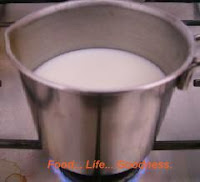Monday, June 22, 2009
You and Your Milk
 Most of us have our morning milk for various reasons. Media publicities have many tactics making the public believe what they want them to believe about milk. There are ads telling milk this milk for kids make them intelligent, the other ads tell this milk makes the bones strong or make you loose weight or non- fat produce and others tell that it prevents osteoporosis.
Most of us have our morning milk for various reasons. Media publicities have many tactics making the public believe what they want them to believe about milk. There are ads telling milk this milk for kids make them intelligent, the other ads tell this milk makes the bones strong or make you loose weight or non- fat produce and others tell that it prevents osteoporosis.Are all milk the same? A mother's milk is similar to a commercial milk? These are the similarities and diversities of the two since the composition of milk differs widely between species. As per my readings, factors such as the type of protein; the proportion of protein, fat, and sugar; the levels of various vitamins and minerals; and the size of the butterfat globules and the strength of the curd are among those than can vary.
Average Element <<<<<< >>>>>> Human Milk<<<<<>>>>> Cow's Milk
Protein <<<<<<<<<<<<< >>>>>>>>>1.1% <<<<<<>>>>>>>> 3.4%
Fat <<<<<<<<<<<<<<<< >>>>>>>>>4.2% <<<<<<>>>>>>>>3.6%
Lactose <<<<<<<<<<<<< >>>>>>>>>7.0% <<<<<<>>>>>>>>4.6%
Energy per 100g (kcal) <<<>>>>>>>>>72.0 <<<<<<>>>>>>>>>66.0
Morover, processed milk began containing differing amounts of fat during the 1950s. A serving (1 cup or 250 ml) of 2%-fat milk contains 285 mg of calcium, which represents 22% to 29% of the daily recommended intake (DRI) of calcium for an adult. Depending on the age, 8 grams of protein, and a number of other nutrients (either naturally or through fortification) such as Vitamines D and K for bone health, B12, B and Rivoflavin for cardiovascular health and energy production, A for the immune funtion, among others. It has also iodine content which is essential for thyroid function, potassium, magnesium and selenium. See more on this topic.
Now that we have a general knowledge of what are in the milk, it's for us to decide whether to drink it or not. Don't be so high on hopes though, there are anti-milk advocates providing strong scientific evidence linking cows' milk and dairy products to a wide range of illnesses and diseases, but this is another story to tell.
Labels:
Cow's Milk,
Human Milk,
Milk,
Milk Composition,
Nutrients
Subscribe to:
Post Comments (Atom)

No comments:
Post a Comment